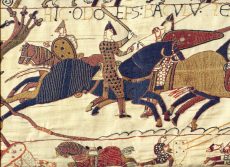
The year is 1066. An old King lies wearily on his death bed. His final few words will prompt an invasion never before seen on English soil and ultimately bring an end to the Anglo-Saxon era, casting England on a bloody trajectory of both fortune and failure for the centuries to come. This was the Norman Conquest of England.
The old King’s name was Edward, better known as Edward the Confessor. He ruled England and its Saxon inhabitants from 1042 until January 5th 1066. He was a good, very religious King and ruled for many years but left no heir to succeed him. There were many people who wanted the throne but it was Edward’s mysterious dying words which were the cause of the Norman invasion.
Duke William of Normandy – a relation of Edward – was supposedly promised the throne of England after Edward passed away. But William was in France and the there was another claimant much closer to home – Harold Godwinson, the Earl of Wessex and second most powerful man in the country after the King himself. Upon hearing of Edward’s poor health, Harold rushed to the King’s side and was with him when he died. Harold was the only one to hear Edward’s last words, so no one knows for sure what was said, but Harold, importantly, claimed Edward named him successor.
This enraged William who immediately began making plans to invade England and take the throne by force. He started building ships, raising an army and carefully planning his attack. The date was set for September.
Meanwhile, King Harold was fully aware of William’s intentions, but he had bigger problems. At this time, a Viking army from Norway began to make its way over to England under the command of King Harald Hardrada. Landing on the North-East coast in mid September, the Viking army made its way down the Humber river and into the heart of northern England where it met a Saxon army waiting for them. This was the first of the three battles that would decide England’s fate. The battle commenced at Fulford Gate near York on the 20th September and lead to a great victory for the Vikings.
Upon hearing this, King Harold who was waiting for William down in the south raced north to confront the Viking hoard. They met at Stamford bridge on 25th September. Both armies stood either side of the bridge and as legend has it, a single Viking warrior walked forward onto the bridge and successfully killed every Saxon who dared challenge him. That was until a cunning Saxon sneaked under the bridge with a large spear and killed the lone Viking. As the battle erupted, Harold Hardrada was slain along with much of his army who fled back to their ships and sailed off to Norway.
Whilst Harold was preoccupied with the Vikings in the north, William seized his chance and sailed across to England, landing at Pevensey on the 28th September. Harold wasted no time and hurried south to where William was waiting. The two finally met at Hastings – the site of perhaps the most famous and critical battle in England’s history. The Saxons dismounted their horses as was the custom, and formed a solid shield wall. The Normans however used their cavalry to their advantage and charged at the Saxons. At first the wall was too strong and it looked as if William himself had been killed but he raised his helmet and reassured his knights. The Saxons continued to successfully fend off the Normans, but the William was a good Commander and tactician. Giving the call, he cleverly pretended to retreat with his forces , turning and running away from the Saxons. Hinking they had won, the Saxons mistakenly broke their wall and chased after the fleeing Normans. However, the trap had worked. The Normans suddenly doubled back on their horses and were able to trample the Saxons. It was at this moment that the tables turned. Out of nowhere, a single arrow shot out of the crowded battlefield and hit King Harold in the eye and with this, William’s men surrounded him and cut him down. William had won.
In the coming months, William strengthened his grip around London and was crowned King on Christmas day 1066. The next few years would see William extend his rule over all England and pass his new kingdom on to his son, ushering in a new age of Norman rule over England.
Image: https://en.wikipedia.org/wiki/Bayeux_Tapestry#/media/File:Odo_bayeux_tapestry.png

0 Comment:
Be the first one to comment on this article.